
THE LAUGHING MAN VOL. 2. NO. 2 – 1981 The Laughing Man Institute.
“The lost element in Christianity is the specific methods and ideas that can, first, show us the subhuman level at which we actually exist, and, second, lead us toward the level at which the teachings of Christ can be followed in fact, rather than in imagination”
Joseph Needleman
Understanding Jesus
‘Lost Christianity’ and the Seven Stages of Life
by David Todd.
“For more than fifteen hundred years, our Western World has been dominated by the personality and the myth of Jesus of Nazareth. The prophecies that announced him, the words attributed to him, the rites that enthroned him, the myths that magnified him, the institutions that supplanted him, have all left their imprint even on seemingly remote parts of Western man’s existence.”1,
Lewis Mumford 
WHY JESUS?
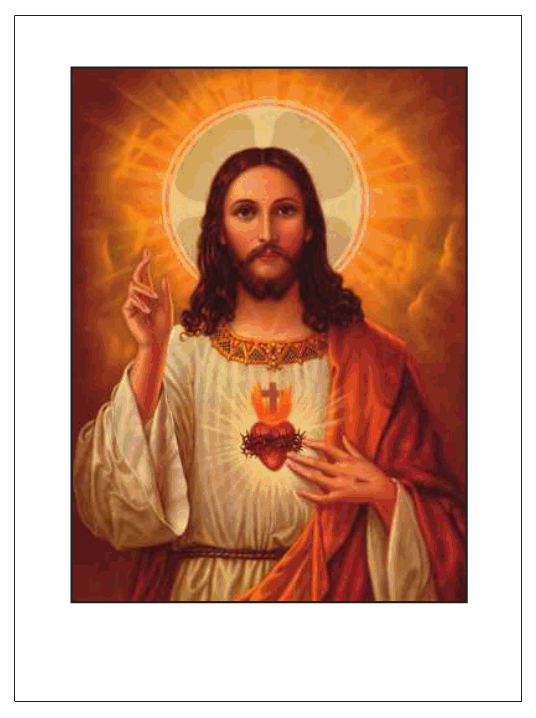
I think that most of us could agree with Mumford’s astute assessment of the historical impact of Jesus of Nazareth on Western culture. However, many thinkers, theologians, mystics, and artists speak and paint diverse and often contradictory pictures of who Jesus was, what he taught, and what his appearance truly meant – and means – to humanity. Jesus has been variously envisioned as the incarnate and only Son of God, an enlightened master of the ancient mystery schools, an inspired but merely human teacher of love and brotherhood, or even a shrewd opportunist grabbing for political advantage by falsely donning the cloak of the Messiah. And the multitude of churches, cults, schools, and sects that claims Jesus as their source and inspiration is equally diverse and contradictory.
The teachings of Jesus have shown remarkable endurance, given the multiplicity of often antagonistic religious forms that was born out of his short life. Perhaps the best explanation for this astonishing persistence is this: at the core of the life and teachings of Jesus there dwells a seed of eternal truth, a manifestation of a reality inherent in all of life.2 It is the truth that people have most responded to in this man, sometimes consciously, more often unconsciously. Thus, through two thousand years humankind has not been able to shake its fascination with and attraction to the heart of Jesus, no matter how hidden, abused, and distorted that initial seed of truth may have become. Somehow, the man Jesus has left an indelible mark in the hearts and minds of Westerners, and we are obliged, however happily or reluctantly, to deal with it.
It was with a certain amount of hesitation that we at The Laughing Man considered focusing an issue on Jesus and the heart of the Christian message. Not that we do not share this almost universal interest in the phenomenon of Jesus – we do. Even so, to get at the root of what Jesus taught, you have to confront and penetrate heavily edited and historically questionable scriptures, the varied religious experiences of millions of followers, and, most difficult of all, the many levels of much – encrusted Western psyche and emotion that have accumulated around responses and reactions to Jesus and his legend. However, when we begin to examine Christianity with an open mind, we recognize quickly that no matter what we consider in the realm of religion and spirituality – be it the role of the teacher, the practice of religious life, or the complex relation between grace and effort, or sin and freedom – our assumptions and behavior are profoundly affected by the persistent influence of this man from Nazareth. Thus, we have no choice. We must understand as much as we can of what is true and false about him and what we are told of him if we are to understand and grow beyond ourselves.
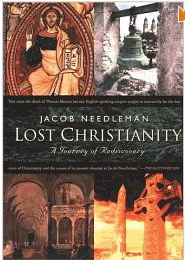
We are not without guides. Some of the greatest devotees of the Christian tradition are honored in the following pages of our magazine – and their spiritual realizations are complemented and brought into focus by the commentary of modern religious scholars and teachers. In this essay I draw particularly on two sources. First is an important new book, Lost Christianity, by Jacob Needleman, the highly respected philosopher and scholar of the “New Religions.” His book, although highly personal, seems to focus and summarize the frustration of many people with the decidedly exoteric nature of modern Christianity. It points to some practical ways in which the tradition might be revitalized to create real changes in the lives of its followers. The other chief source I use is the writings of the modern spiritual teacher, Da Free John, who has commented at length on the life and teaching work of Jesus.
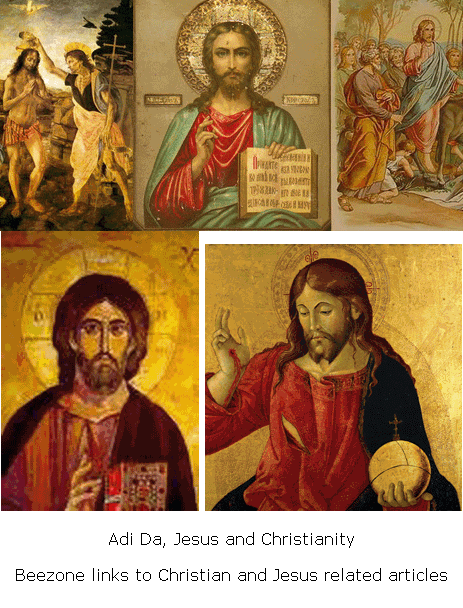
In particular I refer extensively to his developmental model of human life – the seven stages of life.

This model provides a perspective on the hierarchical nature of the spiritual process as described by Needleman and evident within the Christian tradition and other traditions. Through the insights of these two highly respected contemporary authorities (and drawing upon others as well) we can hopefully come to understand Jesus and the whole of Christian life more clearly.
LOST CHRISTIANITY
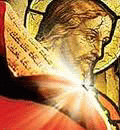
The phrase “lost Christianity” strikes an immediate chord of resonance among many people. I think that most intelligent men and women confronted by the Christian tradition today -whether they stand inside or outside the mainstream of that tradition – share with Needleman the sense that something vital has been “lost” (or hidden) in what we commonly call “Christianity.” The growing interest of many Westerners in the sacred traditions of the East is evidence of widespread disillusionment with, among other things, the common adherence to Christianity as a religion founded in mere belief and not spiritual practice. Needleman himself is a Jew who confesses being both perplexed and intrigued by the possibility of a truly “esoteric” practice of Christian faith. (He wisely defines as “esoteric” that which “works,” that which produces real change in human nature, real transformation.)3 Yet for many years he was frustrated in his attempts to find this transformative, esoteric practice. He felt that those scholars and teachers who claimed to possess the key to the “secret teachings of Jesus” “really had little to say that was significant or understandable to him.4
The situation began to change, however, through Needleman’s contact with three Christian men whose actual practice and understanding of a religious life embodied many elements of the esoteric wisdom he was seeking. These men were: Metropolitan Anthony of Sourozh, an archbishop in the Eastern Orthodox Church; Father Vincent, a Catholic priest and missionary, and Father Sylvan, a monk in a “very old order in the Middle East.” In his conversations with these men and through the study of their writings, Needleman began to identify certain key elements inherent in an esoteric religious practice that he felt were now lost to the mainstream of Christianity.
These elements include the necessity of openness and receptivity, the attainment of freedom from emotional reactivity, and the awakening of the heart as the core of the being. The result of these transforming changes is the realization of the Christian ideal of the exalted love of God and neighbor. All of these aspects of practice taken together compose what Needleman calls the “intermediate level” of Christianity, the stage between mere belief and mystical realization. This concept of the intermediate comes from Father Sylvan who writes: “The idea of levels of Christianity may never again be known in the West. There is an intermediate level of Christianity which teaches the way that the higher level becomes distorted. We need the intermediate level. We need to observe how we lose Christianity, lose mysticism, lose the energy of God. Here lies the origin of sin and repentance, on the border between heaven and hell.”5,
I would like to now consider these elements of the intermediate level in more depth.
In talking to Metropolitan Anthony, Needleman began to feel that “the emotion of a Christian [is] the most lost element of lost Christianity.” The archbishop explained the necessity of emotional vulnerability that leads to true “feeling,” a state more mature than our usual patterns of emotional reactivity and chronic thinking. He says, “This is the whole aim of asceticism: to become open.”6 This openness leads to what the early Fathers called apatheia or freedom from emotions.7 They referred to this state as the doorway to contemplation and an intermediate step toward “the ultimate end of spiritual life . . . the Kingdom of God.”8
This concept of emotional freedom may sound odd, but as Needleman points out, our uncontrolled emotional reactions only tend to serve the egoic self. They rarely express real love, compassion, or wisdom. We are dominated by our own random emotional states. Needleman writes:
“Once a ‘thought’ becomes an emotion, it is impossible to destroy it: one can only suppress it or mask it with another emotion, or hypocritically give it a false name, or simply turn one’s awareness away from it and its effects. All these helpless alternatives have characterized what we know of our culture’s relationship to the emotions, including the most recent-namely, modern psychology’s identification of certain emotions as ‘the unconscious.’ “9
To achieve this state of apatheia or emotional maturity does not come easily. It requires profound inner work or spiritual practice. Needleman describes some of the traditional elements of this practice when he writes:
“As in all of the writings of the early Fathers, the impression given is that this struggle (with the emotions) is a labor of a lifetime, requiring the supernatural grace of the influence of Christ and His teaching, the precise guidance of a holy teacher, and extraordinary persistence and spiritual desire on the part of the monk.”10
This transformation of the emotions leads to a unique realization – the awakening of the heart. Needleman quotes Thomas Merton, who describes the “purity of the heart” taught by the Desert Fathers as a state of consciousness “free of alien thoughts and desires.””
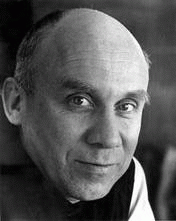
St. Simeon, in the Eastern Orthodox Church, speaks of the highest form of prayer as one that “guides us toward the heart, the center of our being, it does not start from the heart; it leads to the heart, the center of our being. It does not start from the heart; it leads to the heart.” Needleman calls the heart the balancing point between the inner and the outer. To find the place of the heart, he says, is the work of ‘the intermediate stage of Christianity.12
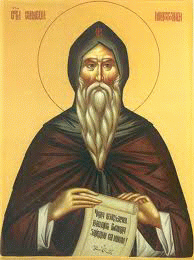
The result of this purification of the heart is the active practice of “love.” In fact, Needleman calls Christianity “the religion of love.” This love, though, is neither superficial nor self-involved. Rather, it is an exalted love that carries one beyond one’s – egoic self and concerns. It is love resulting from real religious practice and transformation. Its greatest expression is to “transmit the teaching to others”-that is, to serve the growth in them of the intermediate principle in human nature.13
Needleman wisely observes that it is our failure to perfect this intermediate level (that is, to achieve “purity of heart”) that obscures the spiritual goal of Christian life. He says, “Throughout Western history the Church has tended to emphasize the goal of man’s life and to underplay or neglect the instrumentality by which the goal may be reached.” Thus, “enormous confusion is bred when purity of intention (love of God, love of the Good) is demanded of man without a compassionate and workable psychological knowledge of everything in the individual human being that resists or covers over such purity of heart.” 14
Herein lies a “terrible irony”: entire societies have assumed that all higher virtues are in fact the innate characteristics of all human beings by the mere fact of birth. Instead, Needleman asserts, these virtues are obviously themselves the results of inner discipline.15 Therefore, it is at the intermediate level that we have to perfect purity of the heart, freedom from emotional reactivity, and the development of free will and attention. This is the key step that can allow the mystical or higher religious awakening many Christians are presently seeking to blossom. Thus, Needleman powerfully concludes that, “. . . the teachings of Christ as we know them are meant for people in a higher level than we ourselves, And the lost element in Christianity is the specific methods and ideas that can, first, show us the subhuman level at which we actually exist, and, second, lead us toward the level at which the teachings of Christ can be followed in fact, rather than in imagination.”16
FIRST BECOME HUMAN
In turning to the spiritual teaching of Da Free John, we find just such a transmission of the teaching of love and moral responsibility. Like Jacob Needleman (and Father Sylvan) he recognizes the “subhuman” (not yet fully human) condition of the ordinary person. He likewise describes an intermediate stage of religious life in which we move from the disposition of living for ourselves alone, self-bound, obsessed with “me,” to one of living in love with God and in service to others. This is the critical stage before true spiritual practice can begin. Da Free John calls this the “fourth stage of life (or more properly the transition from the third to the fourth stage).17
Before discussing this “fourth stage”in more detail, let us each take a moment to examine our individual past and our present stage of human development. In the first seven years (or so) of life, we essentially exist as the physical self. We learn simple motor skills: to eat, drink, defecate, walk, and talk. We primarily depend on our parents for physical sustenance and emotional support.
Then, around age seven, the body’s hormones begin to stimulate the development of our emotional and sexual nature. We notice the opposite sex in a new and intriguing way, and our own sexual capacity and desire begin to come alive. We move out of the sphere of our parents’ ceaseless scrutiny into the preferred society of our peers. As this occurs, there develops a tension between our old patterns of dependency on our parents and our newly aroused need for independence.
By puberty the movement toward autonomy begins to win out. Again our hormones create bodily changes as we assume adult physiques. During our teens, we develop the mental capacities of the verbal mind and abstract thought. As our will continues to develop, we tend to rebel against parents and society. We soon acquire a sense of personal destiny as our attention moves out into the wider sphere of the world. We choose to live in our own way.
All such developmental changes are natural and inevitable. These changes can essentially be equated with the first three stages of life as described by Da Free John: the stages of physical, emotional-sexual, and mental-intentional development. Natural growth in these stages should last in total about twenty-one years.
Thus far we are in general agreement with the mainstream developmental theories proposed by secular authorities (especially psychologists) and with the common observation of our own life. When we consider the next stage of human growth, however, we must have recourse to a religious understanding of human nature and destiny because that is exactly what the next stage is about. It is the awakening to a true religious ‘consciousness. Thus, by the time we are chronologically adults, we should be ready to move on to maturity in the higher, truly spiritual stages of life.
Unfortunately, most of us are stuck at what Da Free John calls the levels of “childish and adolescent approaches to life.” We are still possessed by both our dependent and independent motivations and experience. Because we have grown up in a society that is not principally founded in spiritual truth and informed by the living example of individuals in the higher stages of life, we fail to grow beyond the first three stages ourselves. We may have two arms and two legs and stand upright, but, unless we have developed the higher moral and emotional qualities that separate man from beast, we cannot claim to be real human beings.
What happens, then, if we try to become spiritual when we are not yet fully human? Inevitably, our involvement with religion and spirituality merely reflects our relative immaturity. We either act like a child and relate to God as the great Creator-Parent, or we rebel against and reject the Divine in the doubting and self-conscious mood of adolescence.18 Both dispositions fall short of what it means to become truly human. Prior to such maturity we may enjoy extraordinary insights, revelations, and even “mystical” experiences, but, as Da Free John insists, we fundamentally lack the necessary physical, emotional, mental, and moral foundation to withstand the profound testing and transformation that lie ahead. Therefore, we chronically “backslide” into our self-involvement. Unfortunately, many of us have tried, without this preparation, to jump from relative immaturity to the cultivation of mystical experiences. The signs of our unreadiness appear quickly because our seeking bears no lasting fruits. We must first grow up! To realize this maturity we are required to move beyond our childish and adolescent moods of separation from the Divine and surrender to God in a mood of true sacrifice and relationship.
Achieving suchh a condition of unqualified relationship is no simple matter. In order to mature fully in the first three stages, we must first adapt to appropriate forms of personal and moral disciplines in life.19 We must come under the rule of the law. Therefore, as we grow we not only learn the technique of how to eat, but we must discipline ourselves to eat and live altogether in a life-positive spirit that fully enhances and supports bodily existence and health. Likewise we must mature emotionally from the chronic mood of “you don’t love me” to the active expression of the disposition “I love you.” We must become capable of living as fully sexual beings, free of the impulses of both sexual repression and the selforiented exploitation of mere desire. We then can sustain emotional commitment in sexual relationships free of both withdrawal and promiscuity. Finally, we must move beyond chronically obsessive “verbal-mind chatter” to the awakening of the truly intellectual, higher intuitive, and psychic dimensions of the mind. And to harmonize these physical, emotional, and mental functions our will must develop to direct freely the total feeling energy and attention of the being without the debilitating effects of ceaseless craving for food and acquisitions, random sexual desire, or chronic thinking. Thus, in the words of Jesus, we must “repent,” or recognize our immature and self-defeating habits, and then “sin no more” or go on to change our patterns of behavior. By such means Merton’s “purity of heart” is achieved.
Once we have begun to discipline ourselves in these practical ways, the next step in this transition stage is to begin to adapt to religious and devotional practices. The focus of these practices is the “emotional conversion of the heart,” the turnaround from our self-possession to ecstatic surrender to God. (Here I mean emotional in the sense of the disposition of the entire being. This is a profoundly religious awakening that exceeds even conventional emotional maturity or strength of character resulting from moral disciplines.) By actively living in assumed relationship to the Divine through the practice of devotional worship and prayer, we come into contact with the transforming power or “grace” of the Divine. It is this grace that awakens us beyond ourselves.20
In order to fully understand the implications of this transformation, consider for a moment your own emotional state. Are you fundamentally living in open hearted relationship to others or do you chronically withdraw and collapse into moods of doubt, fear, anger, and sorrow? Are you, in the words of Metropolitan Anthony, full of reactive emotions or are you simply “feeling” whatever confronts you, essentially open and not recoiled in any way? Are you absolutely happy in every situation in life, or do you suffer an “emotional problem” in which you don’t feel loved or capable of fully loving? To be emotionally converted in this sense is to be fundamentally happy and radiant in all circumstances of life-not because you have become merely gleeful or dopey, but rather because you feel fundamentally “connected” to life and in relationship to God as the very Source, or Condition, of your own existence and everything and everyone you confront in every moment.
The way in which this conversion comes about is described in many spiritual traditions. Essentially, it involves both “repentance” (study of spiritual teachings and the development of critical self-knowledge) and “Divine Association,” or association with the revealed Presence of God in sacred places and in the company of illumined teachers and spiritual practitioners. Da Free John writes:
“The best Company . is the Company of God. . . . True religion is simply a matter of maintaining association with God . . . moment to moment. Then the natural emotion, or the force of love, devotion, and self-surrender will tend to be evoked by that Company,”21
This “Divine Association” is the basis of the devotional disciplines at this transitional stage. If our hearts become open, we can always live in relation to God, who is ever-present. When this conversion is essentially true of us we live in constant, felt association with the Divine as a living Presence, or Spirit, evident in everything and everyone. This is the beginning of the fourth stage of life. Then we naturally move from the heart to the awakening of higher psychic and mystical functions of our being. This awakening spontaneously arises out of our self-surrender (whereas, in much of conventional yoga and meditation, it is forced through self-manipulation of attention). At this stage we grow into the inherently evolutionary process of mystical experience and spiritual realization that characterize the higher stages of life.
WORSHIP IN SPIRIT AND IN TRUTH
Now I would like to examine briefly the actual teaching work of Jesus and the various practices in the Christian tradition to consider further what elements have been “lost” since they were originally given by him. At the same time I will further develop the description of the seven stages of life to see how the Christian tradition as we know it relates – to this model of spiritual awakening in the light of Da Free John’s understanding of the teaching work of Jesus.
Jesus apparently taught a progressive system of spiritual practice. Much of the exoteric or public teaching of Jesus, such as the “Sermon on the Mount” and his many parables, was primarily conventional moral instruction. This exoteric teaching also included acknowledgment of the Ten Commandments and other laws relating to right livelihood, right diet, and right action. Principally, though, in the Gospels, we find Jesus speaking of conversion, or the process of being “born again.” The key to this conversion was not only to follow the moral laws but to live by the Great Commandment given by Jesus: “Love the Lord your God with all your heart and with all your soul and with all your mind; and love your neighbor as your self.”
However, as we have seen, one must take up practical and devotional disciplines in order to learn how to love in this exalted and all-encompassing way. It is exactly this kind of practical religious instruction that has been lost to the mainstream of Christianity. Perhaps Jesus gave such instruction to his own disciples, but the Gospels themselves do not speak in any real detail on the contemplative or devotional life necessary to aid this conversion process.22
In the New Testament we do find Jesus speaking of the worship of God “in Spirit and in Truth” and much of this language seems to indicate something of the nature of the spiritual practice given by Jesus to his closest disciples. In his writings on the work of Jesus, Da Free John has done much to fill in some of the missing details not revealed overtly in the Gospels. The following is based on Da ,free John’s understanding of the life of Jesus and the actual spiritual process inherent in each of us.23
In the Gospel of John, Jesus says that, although others have baptized men and women by water, he has come to baptize them with “fire” or the power of the Spirit of God. Ritual baptism by water may be understood to represent the initial conversion to a religious life and acceptance of the grace of the spiritual teacher. But once this conversion has taken place, a person must be baptized into the Spirit-Power and worship God through surrender into that Spirit. In his new book, Scientific Proof of the Existence of God Will Soon Be Announced by the White House!, Da Free John describes the way in which this Spirit worship may be rightly understood:
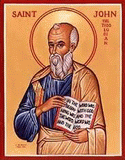
“John’s gospel Teaches that the ‘Living God’ is ‘Spirit.’ That is, God is eternally Present as the All-Pervading Life-Power, with which, therefore, every living being may Commune directly. In fact, the Living God is so intimate with Man that the word ‘Pneuma’ or ‘Life-Breath’ or ‘Spirit’ is used by John the Beloved to describe God. And God is said to be identical to the Spirit, or the Living Energy that pervades the world, and that pervades the nervous system of Man, and that every one of us can contact via the bodily process of breathing and feeling. Indeed, John says not only that Jesus taught that God is the Living Spirit (rather than the idea of God as abstracted Creator), but that he Taught that the Way to worship God is to worship in the Spirit. That is, Jesus taught a method of worship that involved ecstatic bodily Communion with the Life Power via breathing and feeling, based on Truth (or an awakened and secret understanding of the Divine Reality).”24
Although the details of this Spirit worship are not fully disclosed in the New Testament, Da Free John calls it the essential teaching of Jesus. It is the esoteric form of Divine Association given by him. The description of Spirit worship in the Bible is not explicit, however, because this instruction and initiation was given only to those who had matured sufficiently to begin higher spiritual practice. (This is the common practice in almost all such esoteric circles.) There may have been a few “secret” texts that described this esoteric teaching in more detail than the Gospels, but these were apparently lost by early followers and/or suppressed by the orthodox or official Church.25
Once a person has been initiated into this Spirit baptism, he or she begins to experience a natural unfolding of transformative spiritual experiences.26 Through the practice of surrender into the Spirit-Presence, this Presence begins to transform the body and mind of the individual. It begins to draw the attention inward and upward into profound meditative states. Eventually, the attention of the being becomes focused in the subtle centers of the brain, and the person begins to experience the inner, subjective world of mystical visions and trances.27 He or she may see visions of other worlds, celestial beings, or entire realms of light and color. Voices or heavenly music and sounds may be heard through an internal sense of hearing. The body may be filled with blissful energies that may seem to lift the self or “soul” out of the body and ordinary body-consciousness into higher worlds. This stage of internal mysticism is the fifth stage of life.28
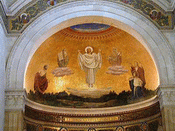
The Transfiguration on Mount Tabor
There is much in the New Testament and other sources that indicates that Jesus also taught this path of mystical ascent to his inner circle of followers as part of the total esoteric instruction he reserved for them. It is part of the natural progression of Spirit worship. “Soul mysticism” was the predominant form of esoteric spirituality common to his time, especially in the Oriental schools of yoga and in the Middle Eastern mystery schools. Thus, we find Jesus saying, “If your eye is single” (that is, if attention is concentrated at the ‘third eye,’ or brain core), “your body will be filled with light.” This is a succinct description of the radiant internal vision that appears when the function of sight is inverted toward its root or source in the brain. This point of light is called by various names in mystical traditions. Jesus named it the “morning star,” the “single eye,” and the key to the “kingdom of Heaven” – the realm of radiant Light intuitively perceived above or deep within and at the crown of the head. In certain traditions of Hindu yoga, this vision is called the “great bndu” (or point) or the “blue pearl.” Many other Biblical statements by and about Jesus, such as the account of his rise or ascent into “Heaven” and the Transfiguration on Mt. Tabor, may also be interpreted asallegorical descriptions of these primal mystical experiences.29
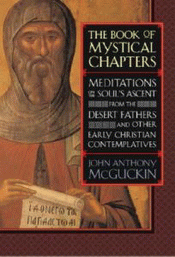
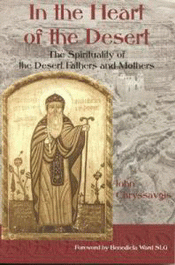
This process of mystical ascent must not be taken as the end of the spiritual process. Many mystical practitioners have, however, believed these experiences to be experiences of the Divine in and of itself. In fact what they are experiencing are the effects of the divine spiritual Power on the nervous system of the body. Such experiential effects must not be mistaken for the actual Realization of God. In the excerpt below from a talk on the relationship between mysticism and the total process of God-Realization Da Free John describes the point of view arising when mystical experiences are wrongly interpreted outside the context of the entire, self-transcending spiritual process:
“Ordinary mystics throughout human history have separated themselves from bodily consciousness by withdrawing attention from the body and from relations, becoming more or less ascetic and concentrated in the brain through various mystical and religious devices of concentration and contemplation and prayer. By detaching themselves from the awareness of the physical, and by entering into the mind itself, such mystics can feel and believe that they are free of the body and of mortality. They see all kinds of abstractions flashing in the nervous system, and the mind explodes into reveries and dreamlike states that seem to take them to other worlds, while glorious and ego-glorifying archetypes come flooding into the conscious mind, detached from physical sensation. These states traditionally were and are regarded to be holy. They were regarded to be the conditions under which God was realized, mortality escaped, and Truth attained…
“Popular religion and mysticism serve the self, or the mind, by providing consoling objects of belief, experience, absorption, attractive states that may seem to fulfill us in the midst of our fear. Ultimately, all psychophysical experience serves the separate being, the separate psycho-physical person that is ‘I.’ Thus, what is popularly conceived to be God-Realization, or mystical absorption, or true religious belief is only a state of mind (or of the limited body-mind), a condition or experience of the manifest personality, Narcissus. Experience, or inwardness, is the hedge around Narcissus, the enclosure of the self. The archetype of Narcissus, who avoids the world by gazing into a pond at his own image, is a metaphor for the ego, the independent self-mind. Like the pond, the mind is a reflective mechanism. Therefore, the ego or the self or Narcissus is a reflection, an illusion of independence. To enter into the realm of the mind, to persist in our flight toward subjectivity, our obsessive experience of separate self, is to be possessed of the self, not of God, no matter how profound the inward phenomena may seem to be at any time.
“The various states of mystical inwardness haze nothing whatsoever to do with God-Realization, absolutely nothing. They are merely experiential states of the separate personality. Mysticial experience is promoted as a solution to suffering, as an answer to doubt and fear, just as saviors and popular religious concepts are often for the same purpose. But the Realization of God or Truth appears, and spontaneously, only in fire instant of self-transcendence, or ecstatic annihilation of mind of inwardness, of self or the reflection of oneself in experience. Ego death, self-transcendence, or the transcendence of the mind, then, is the ‘narrow gate’, the necessary doorway to the realization of Truth. Thus, the old saw that Truth is within is not true. The Truth is absolutely not within. Within is ‘me’. Within is the inside of me. Conventional mysticism and conventional religion are addressed to our inwardness, because the psyche, the inner being and mind, can feel itself to be separate from the body and the physical environment and all the conditions of mortal existence of which we are of afraid, all the conditions that can die.”30
Because of the subtly deceptive nature of mystical experiences, most traditions of esoteric practice stress the necessity of the guidance of a teacher who has himself, or herself, moved through and beyond the stage of mystical absorption. There have been numerous mystics and even great saints who, for lack of such an enlightened guide, have failed to move beyond their mystical experiences. This is not to say they were not great spiritual figures. Their maturity in the esoteric process, even within a religious tradition that, on the whole, was opposed to mystical awakening, far exceeds the aspirations of the usual man or woman. Such saints have perfected the process of Divine association to a high degree, and thus, their lives should serve as great examples to us all of profound religious commitment, compassion, and wisdom. It is certainly the destiny and obligation of all men and women involved in the spiritual process to become such great lovers of God and servants of humanity. Even so, we must understand that this stage is not the final one of God-Realization.
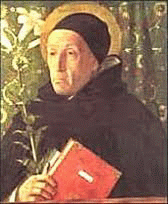
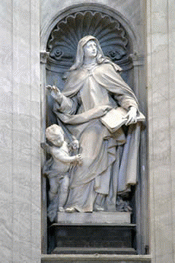
In the Christian tradition there are many saints whose mystical experiences and miraculous powers are well-documented. However, if we carefully read their own accounts, we find that they almost universally lacked the personal guidance of a fully enlightened teacher. For example, in my own study of well known Christian mystics, I have found none (with the possible exception of Meister Eckhart) who seem to me to have passed clearly beyond the mystic (fifth) stage. Teresa of Avila, for instance, who enjoyed many raptures and states of mystic “union,” writes that her most treasured experience was the vision of the Holy Spirit in the form of a dove. Da Free John has shown that this particular vision is associated with the pattern of the two hemispheres of the brain when “viewed” from the brain core.31
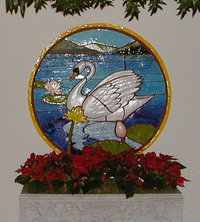
(In the tradition of Hindu yoga this vision is called the “paramahansa,” or great swan.)
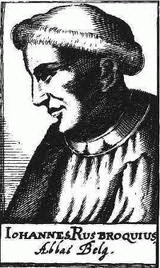
Jan van Ruysbroeck states that although we may experience union with God, we are eternally separate from God.32 Some scholars may say that Ruysbroeck was merely trying to protect himself against charges of heresy for claiming identity with God. Perhaps this was so, but his writings taken as a whole do not indicate that he enjoyed a Realization of God that totally and permanently transcended the self and all experience.
It is just such permanent transcendence of the limited self that marks the end of the mystical stage of practice. The inversion of attention finds its ultimate end in the realization of the Divine Self, the root of all consciousness itself. This realization transcends all visions, all concepts, and all ordinary states and experiences of the body and mind. The seat of pure and Transcendental Consciousness in the body-mind is located in the right side of the heart.33
This is the source of the sense of individual ego-consciousness. Once this illusion of separation is penetrated at the heart, we enjoy perfect identity with God as the Self-principle, or pure conscious being. This Realization initially results in complete absorption in the inner Self, exclusive of the phenomena of the “outer” world. The world of beings and things is seen as an illusion or “nothing.” This transition of absorptive Self-Realization or ego-death is the sixth stage of life.
To look again at the Christian tradition, the works of Meister Eckhart seem to indicate some understanding of the identification of Man with God beyond the experience of mystical union which would correspond to, the sixth stage. In his writings and sermons, Eckhart speaks of the “Godhead beyond God” and the identity of the soul with the Divine, apart from, or to the exclusion of, experience of all worlds. He was in fact convicted of heresy for claiming such things as:
“I am more than all creatures, I am neither God nor creature; I am that which I was and shall remain for evermore. By this sudden touch I am become so rich that God is not sufficient for me, so far as he is only God and in all his divine works. For in this breaking through I perceive what God and I are in common. There I am what I was. There I neither increase nor decrease. For there I am the immovable which moves all things. Here man has won again what he is eternally and ever shall be. Here God is received into the soul.”34

Eckhart’s mysticism has been favorably compared with that of Sri Shankara, the great Sri Shankara vedantin of India, whose philosophy of the exclusive reality of the Self clearly indicates his realization of the sixth stage.35 In Eckhart’s case, it is not clear whether the identity with God of which he speaks was his actual, full realization or if it was merely intuited by him to be the truth.
The process of inner absorption eventually gives way as, in the words of Da Free John, the “eyes of the Self open” to the Realization that everything – both what is perceived as inner and what is perceived as outer – is a direct manifestation of the Divine Itself. This marks the stage of perfect God-Realization, the seventh and final or eternal stage of life. Now we realize that there is only God, and there is no longer any ego, body-mind, or world seen to be distinct from or over against that reality. Rather, all conditions are seen to arise within and as the very Divine.
In the seventh stage, then, we find the perfect realization of what was begun in the fourth stage – the surrender of the entire self into the Spirit and Truth of God. Through such self-sacrificial worship, we come to abide in ecstatic identity with the prior Condition and Reality of all experience, the realm of great Mystery, Divine Truth, and radiant Love.
CONCLUSION
Much more could be said about what has been “lost” and “found” in Christianity’s two thousand years. The elements of Christian life and the individuals that I have mentioned have been covered in a very summary fashion. However, I would hope that Da Free John’s model of the seven stages of life and Jacob Needleman’s description of the intermediate stage of Christianity will be useful in understanding the complex relationships between the various aspects of this tradition, especially those that are truly esoteric in nature. This model, of course, could be applied to any spiritual tradition, but as I mentioned at the outset, we are in particular need of understanding Christianity and its source-the spiritual activity and spoken teaching of Jesus.
It appears, then, that Jesus himself taught a spiritual way that in some way encompassed all of the stages of life, including the essential intermediate stage now “lost” to so many Christians. In his writings on the scope of the work of Jesus, Da Free John has concluded:
“Therefore, if we study and understand Jesus rightly and in Truth, we must transcend the sectarian limitations of the historical Cult of Jesus (or Christianity). Thus, we will necessarily enter into the esoteric domain of religious, mystical, and magical religion, which is communicated in traditions all over the world. But at last we will exceed the conventional limitations of the esoteric mysticism of “soul-development”. Such a course is necessarily implied in the worship of God in Spirit and in Truth. And since such worship was apparently recommended by Jesus himself, we can assume that his highest Teaching embraced this very Realization, exceeding the outer and the inner cults of Man.”36
1. Lewis Mumford, Interpretations and Forecasts: 1922-1972, p. 125.
2. It should at least be noted that one primary factor in Jesus’ endurance as an influential figure was the conversion to Christianity of the Roman emperor, Constantine, in the fourth century A.D. This fact need not deter us from serious investigation of the spiritual truths of Christianity, but it should help us develop a healthy respect for the historical power of political processes in determining exoteric religious persuasions.
3. Jacob Needleman, Lost Christianity (New York: Doubleday and Co., 1980), p. 4.
4. Ibid., p. 22.
5. Ibid., p. 70.
6. Ibid., pp. 23-25.
7. Ibid., pp. 136-39.
8. Ibid., p. lzo.
9. Ibid., p. 139.
10. Ibid., p. 139.
11. Ibid., p. 120.
12. Ibid., p. 162.
13. Ibid., p. 219.
14. Ibid., p. 128,
15. Ibid., p. 125.
16. Ibid., p. 155.
17. Da Free John has described all of human life in terms of seven stages. These stages are the progressive development of all of the functions, including most subtle and spiritual, of the total body-mind. All seven of these stages are discussed briefly in this essay. For a more detailed description see The Eating Gorilla Comes in Peace (1979), chapters 1 and 9-all books by Da Free John are published by The Dawn Horse Press, Middletown, Calif.
18. See Da Free John, Scientific Proof of the Existence of God Will Soon Be Announced by the White House! (1980), pp. 37-43.
19. These practical and moral disciplines are taught by Da Free John and discussed in a number of books including Love of the Two-Armed Forni (1978), The
Eating Gorilla Comes in Peace (19791; antl’Conscious Exercise and the Transcendental Sun (1977).
20. For a description of the religious disciplines and devotional practices taught by Da Free John see Bodily Worship of the Living God (1980).
21. Compulsory Dancing (1980), p. 43.
22. There is much practical wisdom within the monastic traditions of both the Eastern and Western Church. In the Eastern Orthodox tradition we find a very sophisticated understanding of the workings of the human heart as the core of our being. Its meditative practices, especially the “Jesus prayer” (also called “the prayer of the heart”), serve to awaken the unifying function of the heart.
In the Western Church we find in the writings of monks such as Brother Lawrence in The Practice of the Presence of God and Ignatius Loyola in his Spiritual Exercises practical guidance for the awakening to the Presence. These writings, and others, can serve as the basis for a contemplative life in which the felt relationship to the Living Cod may become profound.
23. In Scientific Proof of the Existence of Coil Will Soon Be Announced by the White House!, p. 201, Da Free John explains the basis of the conclusion he makes about the teaching work of Jesus:
“Throughout my lifetime, I have entered into the deepest and most profound spiritual labor, and thus I have uncovered the various dimensions of esoteric realization that pertain to the native psycho-physical structure of Man. I speak as one who has lived the presumption and practice of esoteric Communion with the Living Reality or Divine Source of Man and the world. I have considered all that I have experienced and realized, and I have compared all of it to every kind of historical evidence relative to Jesus and the tradition that developed in relation to him. On the basis of all of this, I have come to the point of intuitive certainty about the essential experience and esoteric Teaching that was shared by Jesus, and John the Beloved, and the inner or initiated community that surrounded them.”
24. Scientific Existence of God Will Soon Be Announced by the While House!, pp. 201-202.
25. See the interview in this issue with Professor Morton Smith, who found a fragment of a “secret Gospel” that was already being suppressed at the time of Clement of Alexandria, an early Church Father of the second century, AD).
26. For a more comprehensive discussion of the process of Spirit baptism and worship, see the talk entitled “Spirit Worship” by Da Free John on pp. 19-26 in this issue.
27. For a complete description of the higher centers of the body and brain see Da Free John, The Enlightenment of the Whole Body (1978), chapter 7.
28. See “The God-Seeing Life” on pp. 44-53 in this issue for classical descriptions of profound mystical experience.
29. See The Enlightenment of the Whole Body, pp. 444-48.
30. Scientic Proof of the Existence of God Will Soon Be Announced by the White House, pp. 161-62.
31. See The Enlightenment of the Whole Body, pp. 4t -21.
32. Ian van Ruysbroeck, The Adornment of Spiritual Marriage, translated by C.A. Wynschenk Horn, edited by Evelyn Underhill (London: John M. Watkins, 1951)
33. Da Free John, along with other spiritual teachers such as Sri Ramana Maharshi and Swami Yogeshwaranand Saraswati, has described the area of the heart on the right side of the chest as the center, or root, of the Transcendental Consciousness.
34. R. Biackney, Meister Eckhart A Modern Translation (New York: Harper and Row).
35. See Rudolf Otto, Mysticism, East and West.
36. Scientific Proof of the Existence of God Will Soon Be Announced by the White House!, p. 221.
For more on Christianity from the writings of Adi Da see:
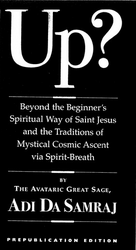
By The Avataric Great Sage, Adi Da Samraj
(this book was later published as Pneumaton)